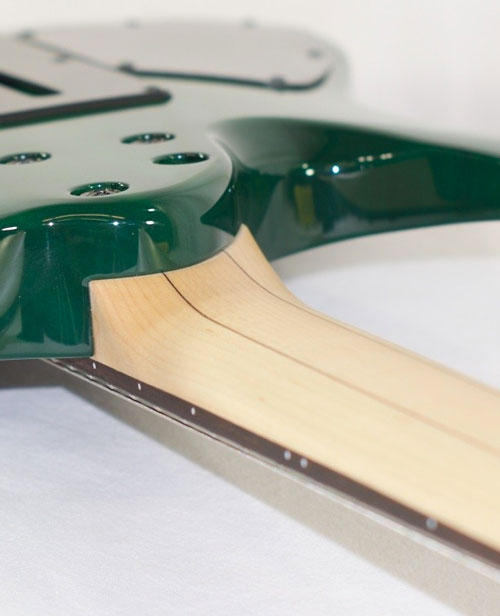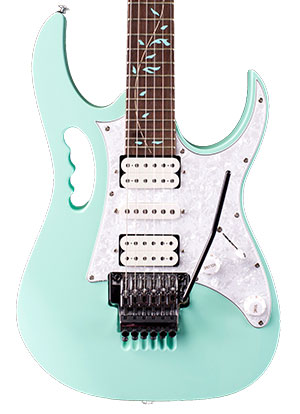With that slight harmonic rake of the strings, followed by an overdriven pick slide, Eddie Van Halen launched a musical revolution with his band's 1978 debut album and reshaped the guitar-making industry.
As rock guitar evolved from the blues-based foundation set by bands like Led Zeppelin and Black Sabbath to become even harder-edged, faster and flashier, young players saw Van Halen’s modified Frankenstrat as an essential component of the sound and no longer coveted the traditional Fender Stratocasters and Gibson Les Pauls carried by the previous generation of six-stringed heroes. They demanded instruments that included the engineering advances that enabled shred.
Rise of the Super Strat
Super Strats were purpose built for Van Halen’s style of hard rock, sometimes in basements and garages, until the industry caught up with demand. Pickups became hotter and the string locks, locking tuners and over-engineered floating tremolos that accompanied them allowed for new sonic possibilities, especially when paired with higher-gain amps.
As Van Halen albums flew off store shelves, American-made brands like Charvel and Kramer reinvented themselves to satisfy the demand, offering custom-shop appointments, like lighter, brighter alder wood bodies, German-made Floyd Rose and Schaller tremolos, thicker sustain-inducing brass trem blocks, hot humbucking pickups from brands like DiMarzio, Seymour Duncan and EMG. But before they became mainstays in the industry, these brands were on the sidelines, building parts to serve Fender players who wanted to tinker with the traditional Stratocaster sound. Using their experience gained by creating replacement parts and custom hot-rodded guitars, brands applied their early lessons to their production lines.
Super Strat Neck Profiles
Super Strat luthiers rejected traditional C- and V-shaped neck profiles, which are not conducive to Van Halen or Stevie Vai-like speeds. Super Strat builders opted to serve flat, broad necks to their players that allowed for searing runs of scales and modes. The necks, depending on manufacturer, were either unfinished, as Van Halen preferred, or heavily lacquered for a uniform look. Neck finish was solely up to the preference of the player, with manufacturers offering an array of models to accommodate their customers.
Kramer, Jackson and Charvel
American-based brands like Kramer offered more traditionally shaped necks on their Barettas and Pacers, opting for simplicity in setup: a single humbucker, volume knob and double locking Floyd Rose tremolo system.
Charvel and its eventual offshoot Jackson Guitars, on the other hand, pioneered compound-radius necks, allowing the fretboard to become broader and flatter as the player reached the upper frets.
Jackson Guitars, which were only available through custom order, began lavishly appointing their ebony fretboards with mother-of-pearl, ivoriod bindings and in-house, hand-wound battery-powered active pickups. While the Randy Rhoads V helped launch Jackson Guitars, the Soloist model brought the brand to the hard rock and heavy metal scene in the early 1980s.
Ibanez and ESP
Non-U.S. brands rode the Super Strat momentum as well. Buttressed by the high-profile celebrity endorsement of Steve Vai, Japan-based Ibanez designed one of the longest lasting artist model guitars, the JEM. Lavishly appointed, the instrument took what players loved about the first American Super Strats and enhanced them.

Ibanez's super thin Wizard neck
With the JEM, Ibanez and Vai took thin necks to new extremes thanks to advances in woodworking technology that was scalable for production models. To make some of the thinnest profile necks in the world, Ibanez invented a new internal truss rod to maintain the structural integrity of the thinner necks. The source of their inspiration? A Jackson Guitar that an Ibanez luthier had x-rayed at his dentist’s office.
The result was Ibanez’s Wizard-profile necks, which were, and continue to be, some of the fastest and thinnest around. Players embraced the JEM so readily that in subsequent years the company launched the Universe, which helped propel the seven-string guitar into vogue with players, and RG series.
Companies like ESP examined what made their competition successful and brought their version to the masses. By manufacturing their higher-end Japanese models under the more affordable sub-brand LTD, ESP launched a new generation of hard rock and heavy metal players that embraced what the Super Strat had to offer.
In the 1980s, each guitar company closely watched what the competition was doing. For example, if ESP would shift production overseas to match a price point with LTD, Jackson would follow suit with their Professional Series. In the U.S., even traditional companies like Fender and Gibson built their own Super Strats, looking to match the players’ new expectations for speed and playability.
As the 1980s wound down, player’s tastes again shifted with the rise of grunge. The Seattle-based rock, and its heavy but less flashy guitar work, again shifted what players wanted out of their instruments.
Over time, the neon colors of the Ibanez RG and airbrushed bikini babes on a Jackson Soloist fell out of vogue in the more muted, gritty 1990s.
As guitar manufacturers continue to reinvent themselves to reflect the times, the Super Strat continues on, albeit with less flashy colors, more utilitarian features and advances in pickup and amplification technology.
Today players are looking to revisit the decadence of the ‘80s, as signaled by the resurgence of brands like Kramer, and climbing prices of older B.C. Rich, ESP, Jackson, Ibanez and Hamer models.
Shredder Guitars Under $500







